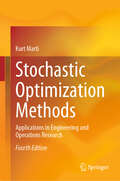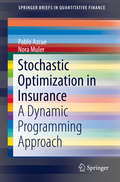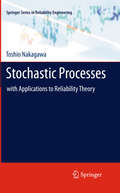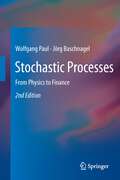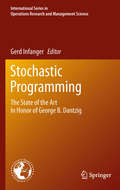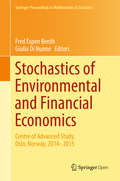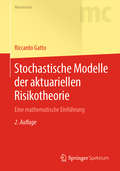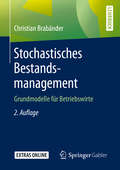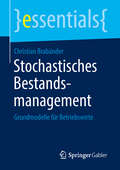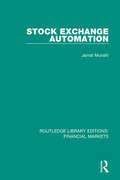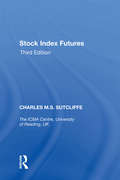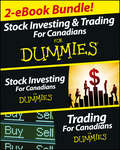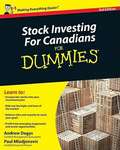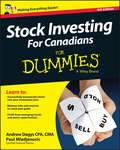- Table View
- List View
Stochastic Optimization Methods: Applications in Engineering and Operations Research
by Kurt MartiThis book examines optimization problems that in practice involve random model parameters. It outlines the computation of robust optimal solutions, i.e., optimal solutions that are insensitive to random parameter variations, where appropriate deterministic substitute problems are needed. Based on the probability distribution of the random data and using decision theoretical concepts, optimization problems under stochastic uncertainty are converted into corresponding deterministic problems.Due to the probabilities and expectations involved, the book also shows how to apply approximative solution techniques. Several deterministic and stochastic approximation methods are provided: Taylor expansion methods, regression and response surface methods (RSM), probability inequalities, multiple linearization of survival/failure domains, discretization methods, convex approximation/deterministic descent directions/efficient points, stochastic approximation and gradient procedures, and differentiation formulas for probabilities and expectations.The fourth edition of this classic text has been carefully and thoroughly revised. It includes new chapters on the solution of stochastic linear programs by discretization of the underlying probability distribution, and on solving deterministic optimization problems by means of controlled random search methods and multiple random search procedures. It also presents a new application of stochastic optimization methods to machine learning problems with different loss functions. For the computation of optimal feedback controls under stochastic uncertainty, besides the open-loop feedback procedures, a new method based on Taylor expansions with respect to the gain parameters is presented. The book is intended for researchers and graduate students who are interested in stochastics, stochastic optimization, and control. It will also benefit professionals and practitioners whose work involves technical, economicand/or operations research problems under stochastic uncertainty.
Stochastic Optimization in Insurance
by Pablo Azcue Nora MulerThe main purpose of the book is to show how a viscosity approach can be used to tackle control problems in insurance. The problems covered are the maximization of survival probability as well as the maximization of dividends in the classical collective risk model. The authors consider the possibility of controlling the risk process by reinsurance as well as by investments. They show that optimal value functions are characterized as either the unique or the smallest viscosity solution of the associated Hamilton-Jacobi-Bellman equation; they also study the structure of the optimal strategies and show how to find them. The viscosity approach was widely used in control problems related to mathematical finance but until quite recently it was not used to solve control problems related to actuarial mathematical science. This book is designed to familiarize the reader on how to use this approach. The intended audience is graduate students as well as researchers in this area.
Stochastic Processes
by Toshio NakagawaReliability theory is of fundamental importance for engineers and managers involved in the manufacture of high-quality products and the design of reliable systems. In order to make sense of the theory, however, and to apply it to real systems, an understanding of the basic stochastic processes is indispensable. As well as providing readers with useful reliability studies and applications, Stochastic Processes also gives a basic treatment of such stochastic processes as: the Poisson process,the renewal process,the Markov chain,the Markov process, andthe Markov renewal process.Many examples are cited from reliability models to show the reader how to apply stochastic processes. Furthermore, Stochastic Processes gives a simple introduction to other stochastic processes such as the cumulative process, the Wiener process, the Brownian motion and reliability applications. Stochastic Processes is suitable for use as a reliability textbook by advanced undergraduate and graduate students. It is also of interest to researchers, engineers and managers who study or practise reliability and maintenance.
Stochastic Processes with Applications to Finance (Chapman And Hall/crc Financial Mathematics Ser.)
by Masaaki KijimaFinancial engineering has been proven to be a useful tool for risk management, but using the theory in practice requires a thorough understanding of the risks and ethical standards involved. Stochastic Processes with Applications to Finance, Second Edition presents the mathematical theory of financial engineering using only basic mathematical tools
Stochastic Processes: From Physics to Finance
by Wolfgang Paul Jörg BaschnagelThis book introduces the theory of stochastic processes with applications taken from physics and finance. Fundamental concepts like the random walk or Brownian motion but also Levy-stable distributions are discussed. Applications are selected to show the interdisciplinary character of the concepts and methods. In the second edition of the book a discussion of extreme events ranging from their mathematical definition to their importance for financial crashes was included. The exposition of basic notions of probability theory and the Brownian motion problem as well as the relation between conservative diffusion processes and quantum mechanics is expanded. The second edition also enlarges the treatment of financial markets. Beyond a presentation of geometric Brownian motion and the Black-Scholes approach to option pricing as well as the econophysics analysis of the stylized facts of financial markets, an introduction to agent based modeling approaches is given.
Stochastic Programming
by Gerd InfangerFrom the Preface... The preparation of this book started in 2004, when George B. Dantzig and I, following a long-standing invitation by Fred Hillier to contribute a volume to his International Series in Operations Research and Management Science, decided finally to go ahead with editing a volume on stochastic programming. The field of stochastic programming (also referred to as optimization under uncertainty or planning under uncertainty) had advanced significantly in the last two decades, both theoretically and in practice. George Dantzig and I felt that it would be valuable to showcase some of these advances and to present what one might call the state-of- the-art of the field to a broader audience. We invited researchers whom we considered to be leading experts in various specialties of the field, including a few representatives of promising developments in the making, to write a chapter for the volume. Unfortunately, to the great loss of all of us, George Dantzig passed away on May 13, 2005. Encouraged by many colleagues, I decided to continue with the book and edit it as a volume dedicated to George Dantzig. Management Science published in 2005 a special volume featuring the "Ten most Influential Papers of the first 50 Years of Management Science." George Dantzig's original 1955 stochastic programming paper, "Linear Programming under Uncertainty," was featured among these ten. Hearing about this, George Dantzig suggested that his 1955 paper be the first chapter of this book. The vision expressed in that paper gives an important scientific and historical perspective to the book. Gerd Infanger
Stochastic Programming in Supply Chain Risk Management: Resilience, Viability, and Cybersecurity (International Series in Operations Research & Management Science #359)
by Tadeusz SawikThis book offers a novel multi-portfolio approach and stochastic programming formulations for modeling and solving contemporary supply chain risk management problems. The focus of the book is on supply chain resilience under propagated disruptions, supply chain viability under severe crises, and supply chain cybersecurity under direct and indirect cyber risks. The content is illustrated with numerous computational examples, some of which are modeled on real-world supply chains subject to severe multi-regional or global crises, such as pandemics. In the computational examples, the proposed stochastic programming models are solved using an advanced algebraic modeling language AMPL and GUROBI solver. The book seamlessly continues the journey begun in the author’s previously published book “Supply Chain Disruption Management: Using Stochastic Mixed Integer Programming.” It equips readers with the knowledge, tools, and managerial insights needed to effectively model and address modern supply chain risk management challenges. As such, the book is designed for practitioners and researchers who are interested in supply chain risk management. Master’s and Ph.D. students in disciplines like supply chain management, operations research, industrial engineering, applied mathematics, and computer science will also find the book a valuable resource.
Stochastic Programming: Modeling Decision Problems Under Uncertainty (Graduate Texts in Operations Research #274)
by Ward Romeijnders Willem K. Klein Haneveld Maarten H. van der VlerkThis book provides an essential introduction to Stochastic Programming, especially intended for graduate students. The book begins by exploring a linear programming problem with random parameters, representing a decision problem under uncertainty. Several models for this problem are presented, including the main ones used in Stochastic Programming: recourse models and chance constraint models. The book not only discusses the theoretical properties of these models and algorithms for solving them, but also explains the intrinsic differences between the models. In the book’s closing section, several case studies are presented, helping students apply the theory covered to practical problems. The book is based on lecture notes developed for an Econometrics and Operations Research course for master students at the University of Groningen, the Netherlands - the longest-standing Stochastic Programming course worldwide.
Stochastic Volatility Modeling (Chapman and Hall/CRC Financial Mathematics Series)
by Lorenzo BergomiPacked with insights, Lorenzo Bergomi's Stochastic Volatility Modeling explains how stochastic volatility is used to address issues arising in the modeling of derivatives, including:Which trading issues do we tackle with stochastic volatility? How do we design models and assess their relevance? How do we tell which models are usable and when does c
Stochastic Volatility and Realized Stochastic Volatility Models (SpringerBriefs in Statistics)
by Makoto Takahashi Yasuhiro Omori Toshiaki WatanabeThis treatise delves into the latest advancements in stochastic volatility models, highlighting the utilization of Markov chain Monte Carlo simulations for estimating model parameters and forecasting the volatility and quantiles of financial asset returns. The modeling of financial time series volatility constitutes a crucial aspect of finance, as it plays a vital role in predicting return distributions and managing risks. Among the various econometric models available, the stochastic volatility model has been a popular choice, particularly in comparison to other models, such as GARCH models, as it has demonstrated superior performance in previous empirical studies in terms of fit, forecasting volatility, and evaluating tail risk measures such as Value-at-Risk and Expected Shortfall. The book also explores an extension of the basic stochastic volatility model, incorporating a skewed return error distribution and a realized volatility measurement equation. The concept of realized volatility, a newly established estimator of volatility using intraday returns data, is introduced, and a comprehensive description of the resulting realized stochastic volatility model is provided. The text contains a thorough explanation of several efficient sampling algorithms for latent log volatilities, as well as an illustration of parameter estimation and volatility prediction through empirical studies utilizing various asset return data, including the yen/US dollar exchange rate, the Dow Jones Industrial Average, and the Nikkei 225 stock index. This publication is highly recommended for readers with an interest in the latest developments in stochastic volatility models and realized stochastic volatility models, particularly in regards to financial risk management.
Stochastics of Environmental and Financial Economics
by Fred Espen Benth Giulia Di NunnoThese Proceedings offer a selection of peer-reviewed research and survey papers by some of the foremost international researchers in the fields of finance, energy, stochastics and risk, who present their latest findings on topical problems. The papers cover the areas of stochastic modeling in energy and financial markets; risk management with environmental factors from a stochastic control perspective; and valuation and hedging of derivatives in markets dominated by renewables, all of which further develop the theory of stochastic analysis and mathematical finance. The papers were presented at the first conference on "Stochastics of Environmental and Financial Economics (SEFE)", being part of the activity in the SEFE research group of the Centre of Advanced Study (CAS) at the Academy of Sciences in Oslo, Norway during the 2014/2015 academic year.
Stochastische Modelle der aktuariellen Risikotheorie: Eine mathematische Einführung (Masterclass)
by Riccardo GattoDieses Buch führt mathematisch präzise in die stochastischen Modelle ein, die bei der Bewertung von Schadensbeträgen für Versicherungen von besonderer Bedeutung sind. Abgedeckt werden Modelle für kleine und große Schadensbeträge, Modelle für extreme Ereignisse, Risikomaße, sowie die stochastischen Prozesse der aktuariellen Risikotheorie: Zählprozesse, zusammengesetzte Prozesse, Erneuerungsprozesse und Poisson-Prozesse. Zentrales Thema ist die Bestimmung der Ruinwahrscheinlichkeit des Versicherers. In diesem Zusammenhang werden analytische Lösungen, asymptotische Approximationen sowie numerische Algorithmen wie die Monte-Carlo-Simulation vorgestellt. Gute Grundkenntnisse in der Wahrscheinlichkeitstheorie werden vorausgesetzt, doch ein Anhang mit den wichtigsten Resultaten erleichtert die Lektüre dieses Buches. Das Buch ist geeignet für fortgeschrittene Bachelor- oder Masterstudierende der Mathematik oder Statistik mit entsprechender Vertiefungsrichtung. Darüber hinaus richtet es sich an Kandidaten, die das Diplom der Schweizerischen Aktuarvereinigung (SAV) erwerben oder sich auf das Diplom der Society of Actuaries (SOA) vorbereiten möchten. Auch praktizierende Versicherungsmathematiker, die ihre technischen Kenntnisse vertiefen wollen, werden angesprochen. Die vorliegende zweite Auflage enthält theoretische Ergänzungen, insbesondere Resultate über die Fluktuationen der Summe und der zusammengesetzten Summe, d.h. des Gesamtschadensbetrages einer Periode. Darüber hinaus erleichtern nun neue Aufgaben verschiedener Schwierigkeitsgrade und mit ausführlichen Lösungen das Selbststudium.
Stochastische Risikomodellierung und statistische Methoden: Angewandte Stochastik für die aktuarielle Praxis (Statistik und ihre Anwendungen)
by Richard Herrmann Torsten Becker Viktor Sandor Dominik Schäfer Ulrich Wellisch Christian Heumann Stefan PilzDieses Buch vereinigt Konzepte und Methoden der stochastischen Modellbildung, der statistischen Analyse und der aktuariellen Anwendung in einem Band. Dabei wird eine kompakte, aber dennoch für Theoretiker wie Praktiker verständliche und interessante Darstellung der Themen Risikobewertung, Datenanalyse, Parameterschätzung, verallgemeinerte lineare Regression, stochastische Prozesse und Differenzialrechnung, Zeitreihen, biometrische Modelle, Credibility sowie Simulation gegeben. Zahlreiche Beispiele illustrieren die Anwendung der Konzepte in der aktuariellen Praxis, wobei auf Modelle aus der Personen- und Sachversicherung und der Finanzmathematik eingegangen wird.
Stochastische Szenariosimulation in der Unternehmenspraxis: Risikomodellierung, Fallstudien, Umsetzung in R
by Frank Romeike Manfred StallingerDas Buch zeigt, wie Unternehmen durch die Anwendung der stochastischen Szenariosimulation ein wirksames und effizientes Risikomanagement umsetzen können. Die einfache Darstellung der Grundbegriffe und Methoden der Stochastik, ergänzt um Beispiele und Fallstudien aus der Praxis, geben dem Leser ein praxiserprobtes Toolkit an Instrumenten für die praktische Umsetzung mit auf den Weg.Die Autoren führen zunächst in die faszinierende Welt des Zufalls ein und erklären die Grundbegriffe der deskriptiven und auch für das Risikomanagement wichtigen Inferenzstatistik. Anschließend geben sie einen Einblick in erforderliche Wahrscheinlichkeitsverteilungen mit deren Risikomaße und Anwendung in der Praxis und beschreiben Verfahren der Risikoaggregation und der Effizienzbewertung von Risiko-Abmilderungsmaßnahmen. Diese Einführung wird begleitet durch konkrete Fallbeispiele, die in der Programmumgebung „R“ umgesetzt wurden.Ergänzend zur Einführung in die spannende Welt der Stochastik werden in einem separaten Kapitel typische Fallstudien aus der Praxis präsentiert. Die Beispiele werden als Sourcecode in der Programmiersprache „R“ für eine praktische Anwendung sowohl im Buch als auch in elektronischer Form von den Autoren zum Download bereitgestellt.
Stochastisches Bestandsmanagement: Grundmodelle für Betriebswirte
by Christian BrabänderDieses Buch erklärt grundlegend das betriebliche Gestaltungsfeld Bestandsmanagement und führt die relevanten Begriffe und Formeln ein. Es beschäftigt sich mit Antworten auf die Fragen, wann Produktbestellungen aufgegeben werden und wie viel auf einmal bestellt werden soll. Dabei werden die Unsicherheiten des zu versorgenden, konsumierenden Prozesses und des Nachschub-Prozesses berücksichtigt. Diese Aufgaben können mithilfe von Modellen optimal gelöst werden. Die wichtigsten Modelle zur Beantwortung der Fragen nach dem Wann und dem Wieviel werden einsteigerfreundlich erklärt und ihre Anwendung an einfachen Beispielen gezeigt. Nacheinander werden das klassische Bestellmengenmodel, das Newsvendor-Modell, das kontinuierliche und das periodische Bestandsmodell erläutert. Weiterführend werden die Anwendungsfälle Zentralisierung und Risikomanagement aus Sicht der Bestandsführung vertieft.
Stochastisches Bestandsmanagement: Grundmodelle für Betriebswirte (essentials)
by Christian BrabänderDieses essential erklärt grundlegend das betriebliche Gestaltungsfeld Bestandsmanagement und führt die relevanten Begriffe und Formeln ein. Stochastisches Bestandsmanagement beschäftigt sich mit Antworten auf die Fragen, wann Produktbestellungen aufgegeben werden sollen und wie viel auf einmal bestellt werden soll. Dabei werden die Unsicherheiten des zu versorgenden, konsumierenden Prozesses und des zuliefernden Nachschub-Prozesses berücksichtigt. Diese Aufgaben können mithilfe von Modellen optimal gelöst werden. Die wichtigsten Modelle zur Beantwortung der Fragen nach dem Wann und dem Wie viel werden einsteigerfreundlich erklärt und ihre Anwendung an einfachen Beispielen und einer Fallstudie gezeigt. Nacheinander werden das Newsvendor Modell, das kontinuierliche und das periodische Bestandsmodell erläutert.
Stock Charts For Dummies
by Lita Epstein Greg SchnellThe easy way to get started in stock charts Many trading and technical analysis books focus on how to use charts to make stock trading decisions, but what about how to actually build a chart? Stock Charts For Dummies reveals the important stories charts tell, and how different parameters can impact what you see on the screen. This book will explain some of the most powerful display settings that help traders understand the information in a chart to find outperformance as its beginning. Stock Charts for Dummies will teach you how to build a visually appealing chart and add tools based on the type of trading or investing decision you're trying to make. It will also introduce you to the pros, cons, and best practices of using three key types of charts: Candlesticks, Bar Charts, and Line Charts. Build and use technical chart patterns Increase profits and minimize risk Track and identify specific trends within charts A unique guide for beginning traders and investors, Stock Charts for Dummies will help you make sense of stock charts.
Stock Exchange Automation (Routledge Library Editions: Financial Markets #8)
by Jamal MunshiOriginally published in 1994, Stock Exchange Automation addresses the pivotal role played by capital markets in the market economics. Capital markets are an essential component of the free market system. The book argues that the capital markets function as an allocator of investable funds among competing uses. The movement toward automated markets requires that we understand how automation changes market behaviour. The book also examines the concept of market microstructure theory, and the implication that some forms of automation should affect prices. Theories of price formation in the specialist based trading system hypothesise that the trading mechanism induces short term price volatility.
Stock Exchange Trading Using Grid Pattern Optimized by A Genetic Algorithm with Speciation: The Case of S&P 500 (SpringerBriefs in Applied Sciences and Technology)
by Rui Neves Tiago MartinsThis book presents a genetic algorithm that optimizes a grid template pattern detector to find the best point to trade in the SP 500. The pattern detector is based on a template using a grid of weights with a fixed size. The template takes in consideration not only the closing price but also the open, high, and low values of the price during the period under testing in contrast to the traditional methods of analysing only the closing price. Each cell of the grid encompasses a score, and these are optimized by an evolutionary genetic algorithm that takes genetic diversity into consideration through a speciation routine, giving time for each individual of the population to be optimized within its own niche. With this method, the system is able to present better results and improves the results compared with other template approaches. The tests considered real data from the stock market and against state-of-the-art solutions, namely the ones using a grid of weights which does not have a fixed size and non-speciated approaches. During the testing period, the presented solution had a return of 21.3% compared to 10.9% of the existing approaches. The use of speciation was able to increase the returns of some results as genetic diversity was taken into consideration.
Stock Index Futures (Innovative Finance Textbooks Ser.)
by Charles M.S. SutcliffeThe global value of trading in index futures is about $20 trillion per year and rising and for many countries the value traded is similar to that traded on their stock markets. This book describes how index futures markets work and clearly summarises the substantial body of international empirical evidence relating to these markets. Using the concepts and tools of finance, the book also provides a comprehensive description of the economic forces that underlie trading in index futures. Stock Index Futures 3/e contains many teaching and learning aids including numerous examples, a glossary, essay questions, comprehensive references, and a detailed subject index. Written primarily for advanced undergraduate and postgraduate students, this text will also be useful to researchers and market participants who want to gain a better understanding of these markets.
Stock Investing & Trading for Canadians eBook Mega Bundle For Dummies
by Lita Epstein Andrew Dagys Paul Mladjenovic Michael GriffisGet these two great books in one convenient ebook bundle! Stock Investing For Canadians For Dummies, Third Edition includes information on stock investing in both bear and bull markets; unique investment segments; stock investing for different types of situations; and examples straight from the real world of stock investing as they have occurred in the past three years. With up-to-date references and resources, this book is the most reliable resource for the new stock market investor. New in this edition: Investigating how governments affect markets: The authors present an unbiased look at how government intervention can and has shaped the markets, so that investors know what to watch for and can respond appropriately to protect their investments—or even benefit Explaining economics: As governments around the world intervene in the markets, media coverage of the economic theory behind these moves (and the economic theories that deplore them) has expanded greatly—and most of it's muddled; new content in the book explains what investors need to know about economics Exploring stock trading: For readers that want to move stocks quickly rather than invest for the long run, the authors offer a crash course in the fundamentals of trading, and some critical do's and don'ts This edition also offers a brand-new part of tens focused on how investors can protect their money and spot warning signs when a good stock is about to go bad Trading For Canadians For Dummies stresses the practice of position trading, conducting technical analysis on a company and its performance, and research methods that enable the trader to strategically select both an entry and exit point before a stock is even purchased. Adapted for Canadian readers, this edition discusses the Toronto Stock Exchange, brokerage options in Canada, and how Canadians can become certified traders. With Canadian examples and resources, this is the only guide to trading tailor-made for Canadians.
Stock Investing For Canadians For Dummies
by Andrew Dagys Paul MladjenovicThe bestselling Canadian guide to building a profitable stock portfolio, revised and updatedWant to make money in stocks without losing your shirt? This practical guide gives you proven strategies for weathering any economic climate and for selecting and managing profitable investments in either a bear or bull market. You'll navigate the new economic landscape and choose the right stocks for different situations - and you'll find fresh real-world examples that show you how to maximize your returns. Get started with the basics - understand stock value, assess your finances, set your investing goals, and know your investing style Recognize the risks - explore different kinds of risk and weigh risk against return Make informed investing decisions - research stocks, understand growth and income investing, and use basic economics to improve your stock strategy Build a strong foundation for your portfolio - investigate industries, evaluate a company's financial health, and understand the effect of government on stock investing Capitalize on emerging sector opportunities - from precious metals to alternative energy, discover the hot sectors that will make your portfolio thrive Build (and hold on to) your wealth - get expert tips and tactics for buying with fewer costs and keeping the CRA at bayOpen the book and find: The differences between stock investing and trading How to understand and use indexes The various types of investment dealers and how to use one New ways to gather stock information online Methods for tracking insider trading Early signs of megatrends that can affect your portfolio Solutions for protecting your profits Canadian investing resources and financial ratiosLearn to: Incorporate stocks into your investment plan Ride out the highs and lows of the market Balance risks and rewards to reach your goals Profit from emerging megatrends and sector opportunities
Stock Investing For Canadians For Dummies
by Andrew Dagys Paul MladjenovicMaster the basics of stock investing? Easy. If you want to learn how to profitably invest in stocks, this is the book for you. This updated new edition of Stock Investing For Canadians For Dummies offers straight answers and simple advice for any Canadian who wants to take control of his or her portfolio. With practical guidance on making wise investments in any market--even today's uncertain one--this plain-English guide covers unique investment segments, how to invest in different market situations, and real and recent examples on what to invest in and when. With fully updated references and resources, this is the perfect stock investing guide for beginners. Updated to include the latest information on the current stock market, as well as fresh case studies Written by expert authors--one an accountant and the other a certified financial planner and investing consultant Ideal for novice investors and those planning for retirement
Stock Investing For Canadians For Dummies
by Andrew DagysThe updated guide to investing in any kind of market environment Stock Investing For Canadians For Dummies keeps you current as the Canadian stock market, industry, and tax laws go through a series of critical changes. Inside, you'll find expert tips and advice on how to navigate flat, thriving, or declining markets. Plus, this friendly, just-for-Canadians guide will help you minimize risk and maximize your investment returns. This latest edition also covers independent online brokers and robo-advisor services, so you can weigh all your options. With up-to-date references and resources, this book is the most reliable guide for the new stock market investor. Invest successfully in a challenging post-pandemic environment that includes international tension, high interest rates, and economic instability Take advantage of trends like the sharing economy, fintech, Web 3.0, decarbonization, cannabis, and more by investing in companies that lead the innovation charge Understand unique Canadian investment segments and situations Learn how to minimize your investing risks See how to invest during periods of inflation Get timely examples and unique perspectives straight from the real-world stock market Stock Investing For Dummies is perfect for readers new to investing in the stock market who are looking for a comprehensive guide to making sure their investments grow.
Stock Investing For Canadians For Dummies (Fifth Edition)
by Andrew Dagys Paul MladjenovicCanada is experiencing a large housing bubble, and if you’re a Baby Boomer looking to downsize, it’s more important than ever to find a way to invest your extra money, especially in a low interest environment. Plus, some very significant tax rules exist (e.g. registered savings plans for retirement and investing, income splitting, and estate planning) that affect investors, and few Canadian publications address these new realities in the stock investing context. Canadian stock investors also have unique opportunities to invest in a recovering domestic commodity sector and a strong dividend-rich and growing financial sector. <p><p> Stock Investing For Canadians For Dummies, 5th edition arms you with trusted information on stock investing in both bear and bull markets; unique investment segments like the legal medical marijuana sector; stock investing for different types of goals, styles, and stages of life; and examples straight from the real world of stock investing as they have occurred in the past few years. With up-to-date references and resources, this fundamentally powerful yet easy-to-read book is the most reliable Canadian resource on stock market investment you can get your hands on!
